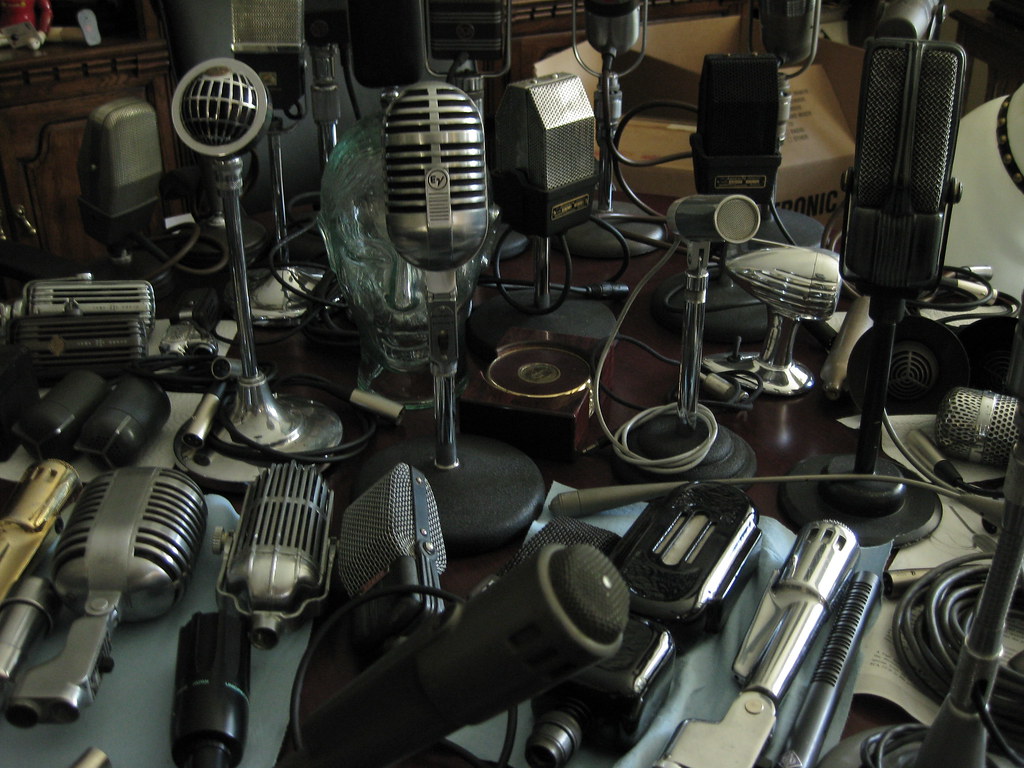
Summary
- I recorded my voice in front of several different types of popular microphones to see what sounded best with my voice, and I edited it in Soundtrap.
Microphone Audition Podcast
My Favorite Microphone
Blue Baby bottle
- The Blue Baby Bottle is a pressure-gradient cardioid condenser
- Has smooth and natural midrange and doesn’t have excessive high-end sizzle
- Read more: http://recordinghacks.com/microphones/Blue-Microphones/Baby-Bottle
- Check out the SM58 Torture Test

Has a smooth and natural midrange and doesn’t have excessive high-end sizzle
Read more: http://recordinghacks.com/microphones/Blue-Microphones/Baby-Bottle
Terms and Concepts
- Microphones
- Dynamic – The sound waves themselves create the electrical signal by moving the membrane diaphragm of the microphone. Very popular and very well known. It is good for the low and middle range, NOT the high range.
- Condenser – The membrane has an electrical current that waits for sound. When the sound waves hit it, it responds instantly. They are all over the place, but they need an electrical charge {amplifier} from something {battery}.
- Polar Patterns
- Omni – Picks sound up from all directions equally. This is used for interviews because it can pick up more than one person, without having to have two separate mics.
- Cardioid – Picks up one half of the microphone, also known as a ‘directional mic’. Most sensitive in the front, about 180 degrees. Shaped like a heart.
- Bi-directional – ‘Figure of 8’, picks the front and behind of the mic, but the 90-degree angle on both sides does not get picked up.
- Transduction – Converts one form of energy to another.
- Voltage – An electric force or a potential difference shown in volts.
- Phantom Power – Activates the condenser in a microphone. DC powered mostly between 12 and 48 DC voltages.
- Sensitivity – Voltage at its known sound level. Can be called by its voltage or decibels. A higher number means more sensitivity, everything is mostly in negatives. Sound pressure.
- Frequency Response – The range of sound the microphone can produce and how sensitive it is within the range. You want it nice and flat.
- Transient – A variation in current, voltage, or frequency.
- Placement – Placement of the microphone is key, depending on the sounds you want, it can just be the distance from you or the instrument from the microphone. This part of the microphone can affect others emotionally in a way to connect with the audience.
- Proximity Effect – Decreased sensitivity to low mics, which reduces background noise and vibration and counteracts when used very close to the source.
- Output – A place where the sound leaves the system.
- Characteristics – This is the Relative Response and Frequency measured in a Hertz graph to show how good or bad the microphone is. This can show the quality of the mic.
- Noise Rating – The signal (sound source) to noise ratio measured in decibels (dB). Noise is any sound in the background you don’t want. Electricity vibrates at 60dB so you want the ratio of the signal and noise to be higher than that. Preferably 90dB or higher.
- Hardware
- Clips – A clip is something that you use to hold a microphone on something {for example – stand }, but, using the wrong kind of clips can affect the performance, make sure it is tight so it has the correct effect.
- Stands – This ties in with a clip, this is what the clip will connect to. This keeps the microphone towards the object you want to hear without having to hold it or keep it still.
- Windscreen – Something that covers and protects the microphone, mostly a foamy material.
- Direct Box – A device used to connect an instrument directly into the audio mixer.
What I Learned and Problems I Solved
- I learned that even though there are many different types of microphones they all don’t do the same thing for sound. They focus on different aspects of sound quality. One problem I had was figuring out which microphone sounded the best with my voice as I listened closely I could hear a difference but was still had to decide which was the best. I figured it out by listening to them all over and taking apart what I liked and didn’t like.